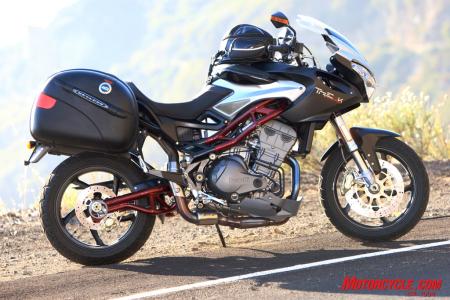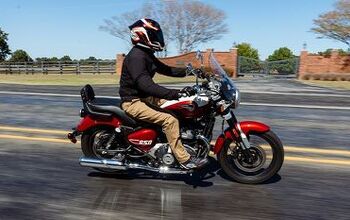2008 Benelli Tre1130K Review - Motorcycle.com
(A quick note: all Benellis available in this country are 2008 models or earlier. EPA and CARB approval for 2009 models is pending.)
For some riders it’s not enough to ride just any bike. The cookie-cutter sportbike or run-of-the-mill sport-tourer no longer satisfies. Oddballs and brands with limited or low production numbers are much more tempting. If you’re ready to step outside motorcycling mainstream, if even just a little bit, but can’t bankroll a Confederate Hellcat and still want a modicum of comfort and utility, we may have your ticket.
Until our review of the Tornado last year we hadn’t sampled a Benelli since a review of the 2004 TNT. Were battin’ a thousand, as we’ve another Benelli (two years in a row now!) in our stables. Welcome the Tre1130K.
Another, slightly different iteration of the Tre K, the Amazonas, is also available.
The Tre1130K Amazonas toes the line of “adventure” bike with its spoke wheels (19-inch front and 17-inch rear), narrow off-roadie tires (110/80 front, 150/70 rear), and wave-style front brake rotors. The pavement-biased Tre K we tested spins Brembo 17-inch cast-aluminum wheels (with more traditional rotors) rolling on large-block tread D616 rubber from Dunlop (120/70 front, 180/55 rear). Otherwise, the bikes are carbon copies of one another.
And perhaps copy isn’t too strong a word in describing Benelli’s current U.S. line-up.
All seven models on offer from Benelli share the same large-diameter steel-tube trellis style frame mated to a stout aluminum casting that serves as an engine mount and swingarm pivot point. An inconspicuous but swoopy cast-aluminum piece makes up the subframe; the swingarm, like the main frame, is a steel-tube trellis type unit sporting large (and rather conspicuous!) eccentric drive chain adjusters. Although the basic chassis design hasn’t changed in at least five years, it’s still easy to appreciate how uncomplicated, minimalist and artful the thing is.
Share and share alike continues in the engine department. All models use the same core powerplant: a 1,130cc (88 x 62mm) liquid-cooled, fuel-injected (Dellorto 50mm T-bodies), 4-valve-per-cylinder, DOHC, cassette-type 6-speed, in-line Triple.
The fully faired Tornado 1130 sportbike we tested last year is the fire-breather of the bunch, boasting a claimed 161 hp and 91.5 ft-lbs, while the Tre K models run a milder state of tune, claiming 123 hp and 85 ft-lbs. Other models fall somewhere in between the Tre K and Tornado’s peak figures.
Dyno time for the Tre – courtesy of our good pal Carry Andrew of Hypercycle – resulted in a rear-wheel figure of 102.8 hp at 9,000 rpm (redline is 9,500). But more important to all us folks in the work-a-day world is the hearty peak torque of 69.5 ft-lbs at a lowly 4,700-ish rpm. Furthermore, the big Triple pumps out 90% (62.3 ft-lbs) of peak torque at just a tick over 3,000 rpm, and maintains around that same percentage for roughly 4,000 rpm after peak. Put a hitch on that thing, we’re pullin’ the family camper!
Though the Tre is a fairly straightforward machine, it does have a little trick up its sleeve. On the lower-left portion of the instrument panel is a push button titled Power Control. This is Benelli’s answer to the growing popularity of pseudo traction control. Not unlike the principle behind Suzuki’s S-DMS, Power Control is claimed to cut power across the rev range by approximately 20% and subsequently improve fuel economy by 10-20%. The idea here is that you might wish to limit some of that wonderful torque in less-than-ideal situations, i.e. rain or low-traction surfaces. Additional dyno runs with Power Control activated showed closer to a 10% rather than a 20% power reduction.
A bit gimmicky? Maybe, but dyno results aside, clutch-assisted 1st gear wheelies didn’t happen as easily as when full power was available. So it seems Power Control is doin’ somethin’.
Firing up the 1,130cc Triple results in a forceful, racy exhaust note. Exhaust gases traveling in the 3-into-1 system must first pass through an ECU-controlled “butterfly” exhaust valve in the collector before exiting the under-seat canister that’s flanked by a trick-looking LED split taillight. For an added “boost of performance,” the exhaust valve opens fully at 3,800rpm, as do a pair of “flaps” in the airbox, for a freer breathing and flowing engine, according to Benelli. But none of that matters ’til ya git ’er warmed up!
Our Tre K test unit was rather cold-blooded most days but after a couple miles of surface street pace it was up to operating temp. Throttle response was crisp, and power develops in a predictable manner. The engine produces notable vibration in lower gears or when under load but once in top-gear cruising speeds it smoothes out considerably. Still, at the end of a ride I often had tingly hands and feets. Some rubber mounts in the handlebars and pegs would do much to quell the vibes.
Also, there’s a surprising amount of valve train clatter when at idle or blipping the throttle. The first time I heard the rattle, I presumed a dry clutch was in operation. Alas, the clutch runs in an oil bath, and a hefty effort is needed to squeeze the clutch lever. These nit picks aside, there’s lots o’ grunt coming out of that Triple, especially right off the bottom.
Springy bits consist of a monstrous 50mm Marzocchi inverted fork and a Sachs shock (Benelli lists the OEM shock from Extreme Tech Damping Solutions). The shock provides for rebound damping adjustment, and an easily accessed hand dial takes care of preload. Strangely, the fork has no adjustments, but there’s nearly 6 inches of travel front and rear. The Tre K offers a smooth freeway ride, soaking up most bumps, yet never seemed wallowy or overly soft. Only the most aggressive canyon dancing or exceptionally rough and broken pavement could upset the suspension enough to create a little wiggle now and then. The wide, tapered upright bars provide good steering leverage, allowing a rider to hustle the Tre through the tight stuff fairly briskly. The gravel-road-ready D616 tire tread never suffered for lack of grip, but don’t expect the front end to be telegraphing heaps of feel like a high-performance sportbike might.
Braking is the work of a pair of 4-piston Brembo calipers pinching 320mm floating discs; a 2-piston Brembo caliper grabs a 240mm rear disc. Though not superbike-spec racing brake performance, power and feel were adequate to haul the 486 lbs claimed wet-weight package in from speed. But we wouldn’t anticipate any less from one of the best binder makers in the business.
My average-size U.S. male frame was quite comfortable on the Benelli, its rider triangle about as ideal as I’ve experienced on any standard/upright-style bike.
Reach to the bars is easy, and the narrow-waisted seat-tank junction (thanks, in part, to the shape of the seat and frame) instills confidence when flat footing from the 30.9-inch seat. Speaking of the saddle, though it looks painfully thin, its firm foam density was surprisingly comfortable. Seat-to-peg distance is roomy but daddy-long-legs riders might find the fit tighter than I did. The footpegs could be wider, or at least longer, and their rubber-covered surface was a skosh slippery at times.
The stylized windscreen is a little smaller than I’d prefer but it is manually adjustable to three positions over a range of around an inch or so. Twist a small knob, one at each side at the base of the screen, and slip it into place. The highest, or most forward, setting seemed to create a little too much buffeting, so I usually kept it in the lowest spot for best results. Really, though, the whole windscreen could be redesigned to reduce buffeting felt at every position. The mirrors, like the rest of the bike, have appealing style, but their best features are the narrow, integrated turn signals. Otherwise they offer an okay if not great view, and are easily adjusted.
The instrument cluster is robust with data. Some of the LCD panel’s numbers are a bit on the small side, and toggling through the tripmeter, odo, lap timer, etc, is anything but intuitive, especially since the engine start button doubles as the instrument toggle/reset switch. I often found myself inadvertently starting the lap timer when all I really wanted to do was zero out the tripmeter. But the centrally located white-faced tach is easy to see at a glance, as is the large number digital speed readout.
Even if the Tre K had an engine made from extra sharp cheddar, rendering the bike useless as a form of transport, it’d still draw a crowd. The Benelli’s saving grace is its eye-catching styling. Sure, power and torque are ample, but the Tre K certainly has competitors (Triumph’s Tiger 1050) capable of at least matching engine performance as well as handling prowess. But anyone willing to plunk down $14,799 (largely the result of low-volume annual production) for the Tre1130K likely isn’t buying this bike for sheer performance.
The Benelli customer will be just as interested in the bike’s excellent fit and finish, high attention to detail and industrial sculpture framework, as they will how well peak horsepower stacks up to the rest of the market players. But as much as anything quantifiable about the Tre, the intangible benefit of gloating comes with having one: You can rest reasonably assured that you’ll be the only Benelli owner for miles around.
(Keep your peepers peeled on Motorcycle.com for an upcoming comparison of the Tre K where we’ll cover a few more details, like the extra cost of the accessory luggage.)
Related Reading
2004 Benelli TNT Review
2008 Oddball Literbikes Comparison
More by Pete Brissette

































Comments
Join the conversation